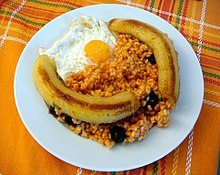Arroz a la cubana (Spanish pronunciation: [aˈroθ a la kuˈβana]) ("Cuban-style rice") or arroz cubano is a rice dish popular in Spain, the Philippines, and parts of Latin America. Its defining ingredients are rice and a fried egg. A fried banana (plantain or other cooking bananas) and tomato sauce (sofrito) are so frequently used that they are often considered defining ingredients too.[1][2]
 Arroz a la cubana - Rice smothered with tomato sauce, plantains and a fried egg | |
| Course | Main course |
|---|---|
| Place of origin | Unknown, possibly Spain |
| Serving temperature | Hot |
| Main ingredients | Rice, fried egg, tomato sauce |
Despite the name, the dish does not exist in Cuban cuisine and its origins are not definitively known.[3][4] It may possibly originate from a Spanish misinterpretation of common Cuban meals of eating rice with stews and a fried egg when Cuba was still a Spanish colony.[3][5]
By region edit
Spain edit
In Spain, a typical dish of arroz a la cubana consists of a serving of white rice with tomato sauce (sofrito) and a fried egg. While the most traditional recipe includes a fried plantain (plátano),[6] it is also common to find the recipe using sausages and bacon.[5]
Philippines edit
In the Philippines, arroz a la cubana has been eaten in the Philippines since Spanish colonial times.[6] Like in other versions, it comes with white rice, fried egg, and some ripe fried cardava or saba banana, sliced length-wise.[7][2][8]
It differs significantly from the Spanish and Latin American versions in that instead of a sofrito, it always includes ground meat (giniling, usually beef) in tomato sauce.[7] This component is typically cooked picadillo-style, with minced potatoes, carrots, raisins, peas, onions, garlic, and other ingredients in a tomato-based sauce seasoned with patis (fish sauce), soy sauce, and sometimes chilis.[8][9][2][10]
A regional variant of arroz a la cubana is arroz de Calamba from Calamba, Laguna. It differs in that it is served with strips of smoked fish (tinapa).[11]
Peru edit
In Peru, it is common for the dish to consist of white rice, fried plantain, a fried hot-dog wiener, and a fried egg over the white rice.[12]
References edit
- ^ Ismael Sarmiento Ramírez, (2003), Alimentación y relaciones sociales en la Cuba colonial, Anales del Museo de América, ISSN 1133-8741, Nº. 11, pp 197-226 (in Spanish)
- ^ a b c Dumlao-Giardina, Rowena. "Arroz a la Cubana (Cuban Rice), The Philippine Way". Apron and Sneakers - Cooking & Traveling in Italy and Beyond. Retrieved 3 January 2024.
- ^ a b Valdéz, Laura L. (24 May 2023). "¿Por qué se llama arroz a la cubana?". La Voz de Galicia. Retrieved 6 January 2024.
- ^ MAD Foundation (2018). Ying, Chris (ed.). You and I Eat the Same On the Countless Ways Food and Cooking Connect Us to One Another. Artisan. p. 161. ISBN 9781579658403.
- ^ a b Cándido Hurones, (2009), Cómo freír un huevo. La innovación didáctica al servicio de la docencia universitaria, Entelequia: revista interdisciplinar, ISSN-e 1885-6985, No. 10, pp. 239-252 (in Spanish)
- ^ a b Antonio Quilis,Celia Casado Fresnillo, (2008), La lengua española en Filipinas: Historia. Situación actual, CSIC, Madrid. (in Spanish)
- ^ a b Ocampo, Selina. "Arroz à la Cubana". Pepper.ph. Retrieved 6 January 2024.
- ^ a b Merano, Vanjo. "Arroz a la Cubana Recipe". Panlasang Pinoy. Retrieved 3 January 2024.
- ^ Manalo, Lalaine. "Arroz a la Cubana". Kawaling Pinoy. Retrieved 3 January 2024.
- ^ "Filipino Picadillo". A Family Feast. Retrieved 3 January 2024.
- ^ Polistico, Edgie (2017). Philippine Food, Cooking, & Dining Dictionary. Anvil Publishing, Incorporated. ISBN 9786214200870.
- ^ Recipe from Perú, using plantain